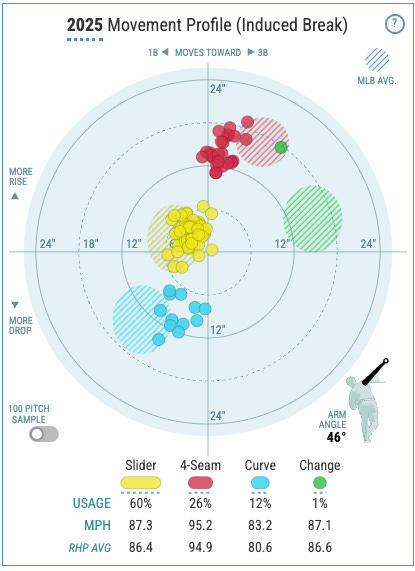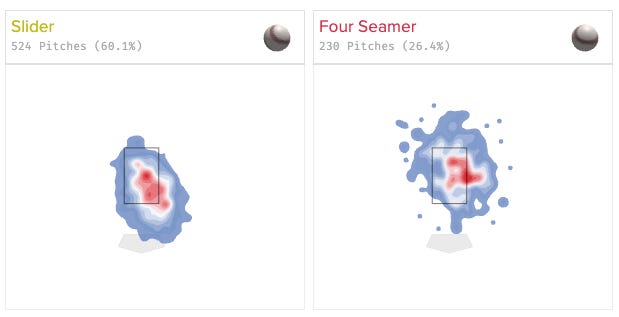What the Atlanta Braves Saw in Trade Acquisition Tyler Kinley
The Atlanta Braves might have just brought PIerce Johnson 2.0 into the organization
The first trade deadline deal for the Braves is here, and it's not a sell-off. Instead of moving Marcell Ozuna or Raisel Iglesias, Atlanta bought a piece for the big-league bullpen: right-hander Tyler Kinley from the Colorado Rockies.
The return was 2021 18th-rounder Austin Smith, a reliever who missed nearly all of 2023 and 2024 after flexor surgery. He currently carries a 5.40 ERA in Double-A Columbus.
Why would the Braves be making an acquisition and why would Kinley be that first move? Let’s talk about it.
Who is Tyler Kinley?
Kinley, 34, was a 16th-round pick out of Division II Barry University1 in 2013, drafted by the Marlins.
He bounced around early in his career — a Rule 5 pick by the Twins in 2017, returned to the Marlins, then claimed off waivers by Colorado in December 2019. He’s had a few injured list stints, but none serious except for flexor tendon surgery in June of 2022 that took him out for a full season.
His career experience for the Rockies consists of 306.1 innings, all in relief, with a 5.08 ERA and 9.4 K/9. Walks have been a bit of a problem, with a 4.5 BB/9, but nothing egregious. In 2025, he went 1-3 with a 5.66 ERA for Colorado, striking out 51 against 27 walks in 47.2 innings. He’s mostly pitched in the 7th or 8th inning and has racked up eight holds, alongside three saves - and three blown ones. Opposing batters hit .230 off of him this season with five homers.
But despite the poor surface numbers, mostly the ERA, there are a few things that you can immediately look at to see what appealed to Atlanta, as well as the potential plan to improve him.
Here’s the blueprint
There’s reason for Atlanta to believe that Kinley could be another version of Pierce Johnson, a Colorado reliever with a career 6.00 ERA for the Rockies that almost immediately became one of the best relievers in baseball after the 2023 trade.
Getting out of altitude helped Johnson, whose 2023 season featured a home ERA of 4.95 and a road ERA of 2.73. The Braves hope it’ll help Kinley, too, who carries a home 7.52 and a road 4.28.
Kinley excels at limiting hard contact — his 86.3 mph average exit velocity ranks in the 95th percentile. (Johnson was the opposite in 2023, giving up 19th percentile hard contact before improving post-trade.)
A usage tweak might also benefit Kinley. Atlanta did this with Johnson, who came to Atlanta with a 55% curveball/30% fastball/15%slider mix and immediately was directed to ramp the curveball up to 75%, eating away at the slider in the process.
It worked - Johnson’s post-trade ERA of 0.76 was the best of any qualified reliever in MLB post-deadline, and he cashed in on a two-year, $14.25M contract that offseason.
Kinley has a similar adjustment period in front of him. He throws two distinct breaking balls, a slider at 87 mph with 60% usage and a 83 mph curveball at 12% usage. The bulk of the remaining usage goes to a 95 mph four-seamer at 26% usage and the occasional changeup, 87 mph and thrown only 11 times out of 872 pitches this season.
Here’s the movement plot for Kinley:
It’s a vertical game, something Atlanta does a lot with their pitching staff (minus Chris Sale and Aaron Bummer). While it’s not a true cutter, Kinley’s slider functions like one; a primary pitch that bridges the vertical and horizontal gap between his fastball and curveball.
There are some tweaks to be made here. Believe it or not, I’m not arguing to throw the slider more. He’s already at the highest slider usage of any reliever that’s thrown 40 or more innings this season. While a little more velocity would be great on the slider, it’s effective enough as is to be a cutter replacement.
I do think the locations could use some work, though. The slider is mostly thrown in the zone and the curveball below, but the fastball sits in or just off the zone, roughly in the same band of the zone as the slider. Here’s a screenshot - see how both are middle-up with a lot of overlap?
Getting the fastball higher in the zone might help, and since pitches tend to lose about four inches of vertical break at altitude, a move to Atlanta could naturally shift those locations upward.
The second tweak I’d make is more curveballs. It’s a newer pitch for him, first being thrown this season, but it’s been practically unhittable. Used primarily against lefties, he’s thrown 107 curveballs and more have resulted in strikeouts (15) than have resulted in balls put into play (10). The two total hits it’s allowed have both been singles with exit velocities of 60.2 and 70.6 mph.
What’s the reason to make this move?
Put simply, the Braves were likely not going to protect the 26-year-old Smith from this winter’s Rule 5 draft, so they flipped him for an established Major Leaguer that you can easily project improvement onto. Kinley has a $5M club option for 2026 with a buyout of only $750k, so Atlanta’s player development group has a chance to unlock surplus value — both in 2025 and potentially beyond.
It’s not a move that wins a World Series by itself — but it might be the kind that helps you finish one.
The Buccaneers





Hey, Braves Today Family
Somebody to watch for debutes tonight for the Augusta Greenjackets (low-A)
Kendy Richard a 6' 4" 20 year old Dominican Right Hander will start tonight. He was promoted when the FCL Braves season ends. His first appearance in Full Season ball.
He was 5 and 0 in Florida. I believe.
He has a 4 pitch mix with a Low 90s Fastball and someone to watch.